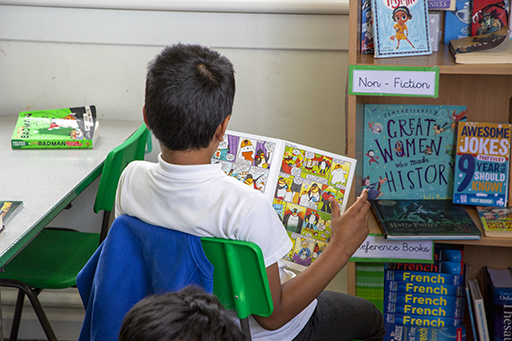2 What ‘counts’ as reading?
When you understand reading as a process of meaning making, it becomes clear how expansive reading is. Every day you read a wide range of texts through multiple different types of media, such as screens, books, leaflets, catalogues, food packaging and so forth. All this reading is of value and plays a role in children’s everyday lives.

The Teachers as Readers research found that when teachers re-evaluated what counts as reading in the 21st century and found out about children’s out-of-school reading practices, they were quite surprised by the wealth of texts with which children engaged (Cremin et al., 2014). Through this process, teachers came to see that no two readers are the same, and this enabled them to offer more focused support to motivate young readers in their classrooms.
To help educators, parents and children themselves recognise and celebrate the expanse of reading children do in their home and community environments, The Open University Reading for Pleasure team created a Reading Treasure Hunt that can be played in families, at school, online or in person. Children (and families, if at home) are encouraged to look around their environment to find reading materials fitting some of the descriptions given (Figure 1). This is a simple but effective tool to develop a shared understanding of ‘what counts’ as reading with your children and families; it also potentially strengthens connections between children’s reading practices at home and in the classroom.
Claire Williams, who teaches 9–10-year-olds in the UK, details how she used the Reading Treasure Hunt in her class in this case study [Tip: hold Ctrl and click a link to open it in a new tab. (Hide tip)] (content starts on page 2). Read the case study now to find out how the activity helped to foster peer relationships and discussion, and how it began to widen children’s and parents’ understanding of what reading encompasses.
Activity _unit3.2.1 Activity 1 24-hour reads
Another activity developed by The Open University’s Reading for Pleasure team is ‘24-hour reads’, which involves noting down the different sorts of texts you have read over the past 24 hours. This can be done by teachers and children and can be displayed in creative ways, such as a collage.
Spend a few minutes now making a note of the different sorts of texts you have read over the past 24 hours, as in the example in Figure 2, then answer the questions that follow.
- For each text type, make a quick note of your purpose for reading, for example, was it for information, to socially connect or entertainment?
- Now reflect on how you made meaning. Did you only decode the alphabetic script? Did you recognise logos or icons? Did you interpret emojis? Did you build meaning from a combination of written words, still or moving images and other visual cues?
Comment
A greetings card from a friend may be a vehicle for social interaction, you may have read the words, but also interpreted the sentiment they were conveying through the nature of the image. Seeking information on a website, you may have been drawn first to a familiar brand logo, before reading the product description.
This activity highlights how all reading is purposeful and legitimate. As educators, it is essential to find out about, acknowledge and celebrate all the reading that children do and validate their emerging reader identities. For many children, much of their out-of-school reading may be with digital technology. Whilst ‘screen time’ tends to be portrayed negatively in the media, it is important to take a balanced view. You will consider this in more detail in the next section.


